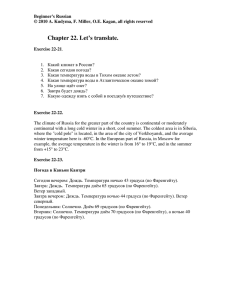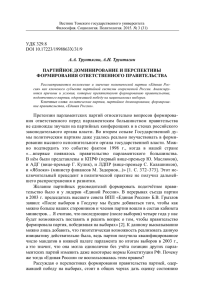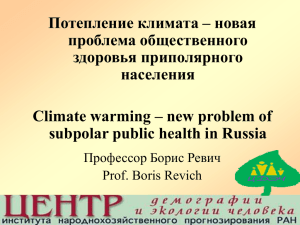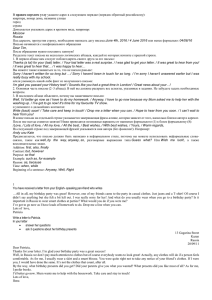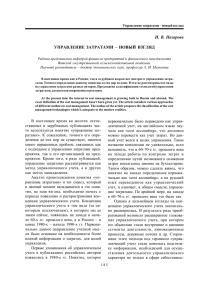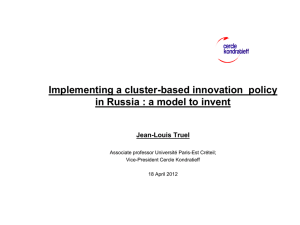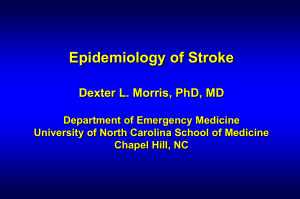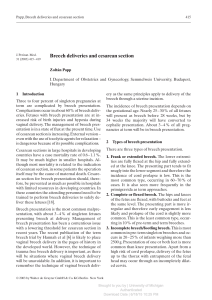Causes of death and methods of their analysis.
реклама
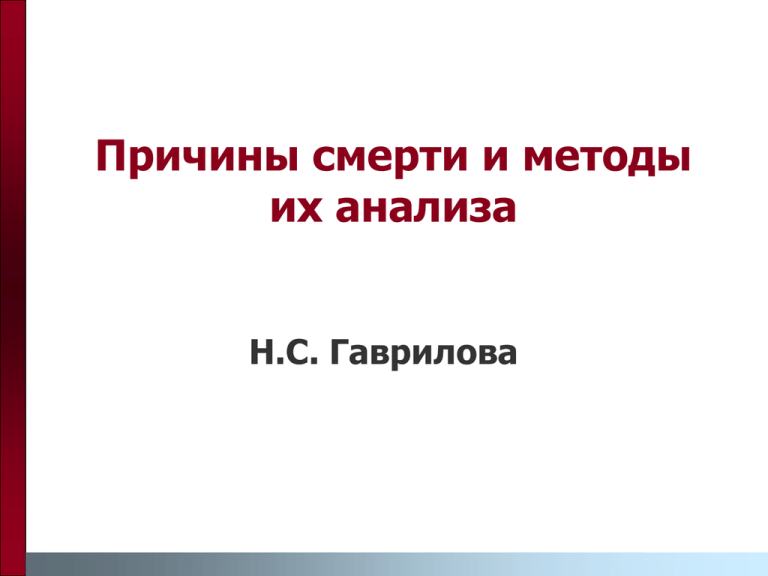
Причины смерти и методы их анализа Н.С. Гаврилова Causes of death and their classification Established by the World Health Organization as International Classification of Diseases (ICD) Has several revisions. The most recent revision is the 10th revision. Adopted by most countries in the mid 1990s Classification of causes of death in Russia Classification of causes of death used in the Soviet statistical forms was different from WHO classification. Form #5 (later called form C51) had 185 causes of death. Main differences between WHO and Soviet classification are found in the groups of CVD and injuries New classification of causes of death in Russia After dissolution of the Soviet Union most FSU countries continued to use the old classification of causes of death In 1999 Russia adopted a new classification of causes of death corresponding to the 10th ICD revision Still incompatible with the WHO classification Selected Causes of Death Total Cancer CardioVD IHeartD CerebrVD Accident USA (1994) Germany (1995) Russia (1995) 776.1 195.0 307.2 157.6 48.0 55.5 764.1 196.7 343.8 151.2 78.3 41.2 1513.8 200.8 795.8 378.9 288.8 234.3 Major causes of death within the group of injuries. Men Иванова и др., Demoscope Weekly, N181-182, 2004 Major causes of death within the group of injuries. Women Иванова и др., Demoscope Weekly, N181-182, 2004 Degradation of mortality statistics in Russia Pace of Growth of Age-Adjusted Mortality in 1989-2000 for Classes of Causes of Death 9 8 7 6 5 Males Females 4 3 2 1 0 All causes Injuries Ill-Def.C. Infections Proportion of deaths from illdefined conditions is a measure of quality of mortality statistics Proportion higher than 5% indicates poor quality In developed countries most deaths from ill-defined conditions are diagnosed at older ages Is this increase in mortality from ill-defined conditions related to more cases of deaths from senility? Age Profile of Mortality from Ill-Defined Conditions in Russia Males Females 160 140 2001 1991 Age-Specific Mortality per 100,000 Age-Specific Mortality Rate per 100,000 200 150 100 50 120 2001 1991 100 80 60 40 20 0 0 0 20 40 Age 60 80 0 20 40 Age 60 80 Top Five Causes of Death for Young Adult Males (20-24) 1990 2001 Injuries Injuries Neoplasms Symptoms, Signs and IllDefined Conditions Diseases of Circulatory System Infectious Diseases Symptoms, Signs and IllDefined Conditions Neoplasms Diseases of Nervous System and Sens.Organs Diseases of Respiratory System Top Five Causes of Death for Young Adult Females (20-24) 1990 2001 Injuries Injuries Neoplasms Neoplasms Diseases of Circulatory System Diseases of Circulatory System Complications of Pregnancy and Childbearing Symptoms, Signs and IllDefined Conditions Diseases of Nervous System and Sens.Organs Infectious Diseases Which Causes of Death Are Hidden Behind the Ill-Defined Conditions? We Used Individual Death Certificates With More Detailed Description of Circumstances of Death Collected by Kirov Department of Health Kirov is a Typical Russian Region with Lower than Average Mortality from Ill-Defined Conditions Age-Adjusted Mortality from Injuries in 1996 for Russian Males Aged 0-64 years Data from the WebAtlas Project (http://sci.aha.ru/ATL) Deaths from Ill-Defined Conditions in Kirov Region of Russia in 2003 Sudden infant death (R95) 3.3% Decomposition in water (river, well, pond) (R99) 13.0% Decomposition at home (R99) 53.5% Decomposition in garden, summer house (R99) 1.7% Decomposition in forest or field (R99) 6.0% Decomposition in nonresidential building, on the street (R99) 12.3% Decomposition in water pipe (R99) 0.7% Decomposition on the cemetery (R99) 0.3% Decomposition in bath, lavatory or barn (R99) 1.0% Decomposition in other place (R99) 5.5% unknown (R99) 2.3% senility (R54) 0.3% Ill-defined conditions and external deaths of undetermined intent are two sides of the same coin It appears that both causes of death may be used for concealing criminal cases of violent death Mortality in Moscow city 80 Ill-defined conditions injuries of undetermined intent Age-adjusted death rate per 100,000 70 60 50 40 30 20 10 0 1996 1998 2000 2002 Year 2004 2006 Top Five Causes of External Mortality in Russia and Moscow in 2001 Russia Moscow Suicide Accidental Falls Undetermined Injury Undetermined Injury Homicide All Other Accidental Causes Accidental Poisoning by Alcohol Homicide All Other Accidental Causes Suicide Autopsies in Russia Autopsies are used to verify cause of death Autopsy is mandatory for violent death, death of woman during pregnancy, labor or postpartum period, death of infant below 1 year, death from cancer not supported morphologically, death from any infectious disease Situation with medical examiner services Only 34-48% of jobs are filled by physicians 38-54% of jobs are filled by histologists 35% of workers reached retirement age Additional reading Gavrilova N.S., Semyonova V.G., Dubrovina E., Evdokushkina G.N., Ivanova A.E., Gavrilov L.A. Russian Mortality Crisis and the Quality of Vital Statistics. Population Research and Policy Review, 2008, 27: 551574. Measures of Mortality Crude Death Rate Age-Specific Death Rates (AgeSpecific Mortality Rates) Age-Adjusted Mortality Rates (Standardized Mortality Rates) Life Expectancy (at birth or other age) Measures of Infant Mortality Crude Death Rate Number of deaths in a population during a specified time period, divided by the population size "at risk" of dying during that study period. For one-year period, Crude Death Rate, CDR = Deaths in that year /mid-year population size x 1,000 to adjust for standard-sized population of 1,000 persons mid-year population = total population for July 1 Crude Death Rate Pros and Cons Pros: - Easy to calculate, and require less detailed data than other mortality measures - Useful for calculation of the rate of natural increase (crude birth rate minus crude death rate) Cons: - Depends on population age structure (proportions of younger and older people) Trends in crude death rates (per 1,000) for Russia, USA and Estonia Distribution of crude death rates (per 1,000) in Russia, 2003 Age-Specific Death Rates (ASDR) or Age-Specific Mortality Rates (ASMR) Number of deaths in a specific age group during a specified time period, divided by the size of this specific age group during that study period. Example: For one-year study period, Age-Specific Death Rates, ASDR for males at age 45-49 years = = Deaths to males aged 45-49 in that year / Number of males aged 45-49 at mid-year x 1,000 to adjust for standard-sized population of 1,000 persons of that age. Age-Specific Death Rates Pros and Cons Pros: - Allows to study mortality by age (and sex) Cons: - Requires detailed data on deaths by age (not always available for developing countries, war and crisis periods, historical studies) Infant Mortality Rate, IMR Proportion of infants who die in their first year Number of deaths under age one during a specified time period, divided by the number of live births For one-year period, Infant Mortality Rate Deaths under age one in that year IMR Number of live births in that year x 1,000 to standardize per 1,000 live births Infant Mortality Rate Pros and Cons Pros: - Sensitive indicator of overall health conditions in a country, particularly child health - Useful for indirect estimates of mortality in other age groups through imputation, using the socalled "model life tables" Cons: - Requires accurate data on births and infant deaths (not always available for developing countries, war and crisis periods, historical studies) Changes in infant mortality in Russia, USA and Estonia Definition of live birth in the USSR was not consistent with WHO definition WHO definition of live birth: "the complete expulsion or extraction from its mother of a product of conception, irrespective of the duration of pregnancy which, after such separation, breathes or shows any other evidence of life, such as beating of the heart, pulsation of the umbilical cord or definitive movement of voluntary muscles, whether or not the umbilical cord has been cut or the placenta is attached.“ The Soviet Union adopted a less inclusive definition, excluding infants born before 28 weeks and those weighing less than 1000 grams, regardless of signs of life. Soviet definition resulted in underestimation of infant mortality After getting independence, many FSU countries adopted WHO definition of live birth Distribution of infant mortality in Russian regions, 2003 Стандартизованные показатели Стандартизованный коэффициент (прямой метод) Стандартизованное отношение смертности Потенциальные годы потерянной жизни Age-adjusted death rate (ADR), standardized death rate (SDR) or age-standardized death rate (ASDR) Death rate expected if the studied population had the age distribution of another "standard" population (arbitrary chosen for the purpose of comparison). Calculated as weighted average (with weights being proportions of the "standard" population at each age) Age-Adjusted Death Rate or Age-Standardized Death Rate Direct method of age standardization: P si M ui ADR = i Ps Mui is mortality rate in the studied population at age i Psi – number of persons at age i in the standard population. Ps – total standard population. Age-Adjusted Death Rate or Age-Standardized Death Rate Pros: - Allows comparison of death rates of populations despite differences in their age distribution Cons: - Requires data on death rates by age (not always available for developing countries, war and crisis periods, historical studies) - Results of comparison may depend on the arbitrary choice of standard. Стандартизованное отношение смертности или Standardized mortality ratio Du SMR = P ui M si i где Du - суммарное число умерших в изучаемой популяции, Msi - коэффициент смертности в стандартной популяции в возрастной группе i, Pui - численность населения в возрастной группе i для изучаемой популяции Стандартизованное отношение смертности Полезно использовать для маленьких регионов и редких причин смерти За стандартное распределение обычно выбирается распределение смертей по всей стране Потенциальные годы потерянной жизни Potential Years of Life Lost (PYLL) ai = T xi PYLL = Di ai где T - верхний предельный возраст, до которого рассчитывается недожитие (обычно 70 или 65 лет), x - середина соответствующего возрастного интервала. i Потерянные годы потенциальной жизни рассчитываются как сумма произведений числа умерших на недожитые годы в каждой возрастной группе Коэффициент потерянных лет потенциальной жизни рассчитывается соответственно: RatePYLL = PYLL/Pu где Pu - численность изучаемого населения в возрасте от 1 до T. The Concept of Life Table Life table is a classic demographic format of describing a population's mortality experience with age. Life Table is built of a number of standard numerical columns representing various indicators of mortality and survival. The concept of life table was first suggested in 1662 by John Graunt. Before the 17th century, death was believed to be a magical or sacred phenomenon that could not and should not be quantified. The invention of life table was a scientific breakthrough in mortality studies. Life Table Cohort life table as a simple example Consider survival in the cohort of fruit flies born in the same time Number of dying, d(x) Number of survivors, l(x) Number of survivors at the beginning of the next age interval: l(x+1) = l(x) – d(x) Probability of death in the age interval: q(x) = d(x)/l(x) Probability of death, q(x) Person-years lived in the interval, L(x) Lx = x lx + lx + x 2 L(x) are needed to calculate life expectancy. Life expectancy, e(x), is defined as an average number of years lived after certain age. L(x) are also used in calculation of net reproduction rate (NRR) Calculation of life expectancy, e(x) Life expectancy at birth is estimated as an area below the survival curve divided by the number of individuals at birth Life expectancy, e(x) T(x) = L(x) + … + Lω where Lω is L(x) for the last age interval. Summation starts from the last age interval and goes back to the age at which life expectancy is calculated. e(x) = T(x)/l(x) where x = 0, 1, …,ω Life Tables for Human Populations In the majority of cases life tables for humans are constructed for hypothetic birth cohort using crosssectional data Such life tables are called period life tables Construction of period life tables starts from q(x) values rather than l(x) or d(x) as in the case of experimental animals Formula for q(x) using age-specific mortality rates qx = Mx 1 + (1 ax ) Mx a(x) called the fraction of the last interval of life is usually equal to 0.5 for all ages except for the first age (from 0 to 1) Having q(x) calculated, data for all other life table columns are estimated using standard formulas. Life table probabilities of death, q(x), for men in Russia and USA. 2005 1 0 10 20 30 40 50 60 log(q(x)) 0.1 0.01 0.001 0.0001 Age Russia USA 70 80 90 100 Period life table for hypothetical population Number of survivors, l(x), at the beginning is equal to 100,000 This initial number of l(x) is called the radix of life table Life table number of survivors, l(x), for men in Russia and USA. 2005. 120000 100000 80000 Russia 60000 USA 40000 20000 0 0 10 20 30 40 50 60 70 80 90 100 Life table number of dying, d(x), for men in Russia and USA. 2005 Russia USA 3500 3000 d(x) 2500 2000 1500 1000 500 0 0 10 20 30 40 50 Age 60 70 80 90 100 e(x) Life expectancy, e(x), for men in Russia and USA. 2005 80 70 60 50 40 30 20 10 0 Russia USA 0 10 20 30 40 50 Age 60 70 80 90 100 Trends in life expectancy for men in Russia, USA and Estonia Distribution of life expectancy, Men, 1999 Special methods based on life table approach Таблицы смертности множественного выбытия Таблицы смертности при устранении причины смерти Декомпозиция ожидаемой продолжительности жизни Таблицы смертности множественного выбытия Multiple decrement life tables Часто используется для построения таблиц смертности по причинам Декременты – смерти от различных причин Таблицы смертности множественного выбытия – этапы построения Построить обычную таблицу смертности от всех причин Рассчитать вероятность смерти от причины k q kx = q x M kx Mx = qx D kx Dx Таблицы смертности множественного выбытия – этапы построения (продолжение) Рассчитать число декрементов причины k в интервале (x, x+n): от d kx = q kx l x Рассчитать числа доживших до возраста y для тех, кто в течение последующей жизни умрет от причины k: k x d l = x =y k x Таблицы смертности множественного выбытия – этапы построения (продолжение) Рассчитать вероятность умереть данной причины в течение жизни: lk/l0 от Рассчитать средний ожидаемый возраст умерших, рассчитав соответственно Lkx и Tkx Рассчитывается так же как ожидаемая продолжительность жизни в обычной таблице Средний ожидаемый возраст смерти по причинам, женщины России Васин С., доклад в Киеве 2006 Вероятность для новорожденного умереть на протяжении жизни от семи групп причин смерти (на 100 родившихся), мужчины России БСК и новообр. – правая ось Васин С., доклад в Киеве 2006 Сравнение структуры смертности мужчин России и Западных стран. 1965 год Васин С., доклад в Киеве 2006 Сравнение структуры смертности мужчин России и Западных стран. 2004 год Васин С., доклад в Киеве 2006 Декомпозиция продолжительности жизни по возрасту и причинам смерти Метод декомпозиции Предложен Андреевым (1982), Поллардом (1982) и Арриагой (1984) Декомпозиция по возрасту x = l 1 x l 1 0 L l 2 x 2 x L l 1 x 1 x + T 2 x +n l 1 0 l 1 x l 2 x l 1 x +n l 2 x +n где величины lx, Lx, Tx представляют собой стандартные величины из обычной таблицы смертности, а индексы 1 и 2 соответствуют не возведению в степень, а популяции 1 и популяции 2 соответственно (то есть двум сравниваемым популяциям). Необходимо рассчитать обычные таблицы смертности для двух сравниваемых популяций Декомпозиция по возрасту = l 1 l 10 T 2 l2 T 1 l1 Последний открытый возрастной интервал Декомпозиция вклада отдельных причин в различия по продолжительности жизни i x = = m x i (2 ) x m (2 ) x R ix(2 ) m (x2 ) x m (x2 ) m i (1 ) x m (1 ) x R ix(1 ) m (x1 ) m (x1 ) где Rix обозначает пропорцию смертей от причины i в возрастной группе (x, x+n), то есть Dix/Dx. В данном случае Dix соответствует наблюдаемому чилу умерших от причины i в возрастном интервале (x, x+n), а Dx - соответсвующее число умерших от всех причин. Декомпозиция по причинам смерти Индексы (1) и (2) соответсвуют сравниваемым популяциям. Значения mx соответсвуют табличным коэффициентам смертности от всех причин, которые можно получить из обычной таблицы смертности, поскольку mx = dx/Lx. В данной формуле величина Δx соответствует вкладу различий в смертности от всех причин в возрастном интервале (x, x+n) в наблюдаемые различия в i ожидаемой продолжительности жизни. Можно показать, что x = x i а также что e (1 ) 0 (2 ) x e = x x i x = x i Decomposition of the U.S.-Russia gap in life expectancy by cause USA – 1999; Russia – 2001. Source: Shkolnikov et a. Mortality reversal in Russia. Decomposition of the U.S.-Russia gap in life expectancy by cause USA – 1999; Russia – 2001. Source: Shkolnikov et a. Mortality reversal in Russia. Contribution of different causes of death to changes in LE, men Contribution of different causes of death to changes in LE, women Age and cause components of LE increase due to anti-alcohol campaign: Men Age and cause components of LE increase due to anti-alcohol campaign: Women Contribution of causes of death to 40e20(CA) - 40e20(Slav) Males (total difference = 2.90 years) 1.8 1.6 1.4 1.2 1.0 0.8 0.6 0.4 0.2 au se s O th e rc ju rie s In CV Re D sp ir a to ry Di s. Di ge st iv e Di s. pl as m s Ne o In fe ct io ns 0.0 Contribution of causes of death to 40e20(CA) - 40e20(Slav) Females (total difference = .28 years) 0.35 0.30 0.25 0.20 0.15 0.10 0.05 au se s O th e rc ju rie s In Di s. e es t iv CV D pl as m s Di s. Di g -0.10 Re sp ir a to ry In -0.05 Ne o fe ct io ns 0.00 Additional reading Preston S. H., Heuveline P., Guillot M. Demography. Measuring and modeling population processes. Blackwell Publ., Oxford, 2001. Таблицы смертности при устранении причины смерти Таблица смертности при устранении причины смерти Использует свойство аддитивности интенсиности смертности m x = m + m + ... + m 1 x 2 x k x Метод Чанга (1978) – допущение пропорциональности смертности от отдельных причин k a =r k a , x a x+n Основная формула для расчета таблицы смертности при устранении причины смерти k qx = 1 (1 1 qx ) r В данной формуле индекс –k означает не возведение в степень, а тот факт, что показатель относится к случаю, когда причина смерти k устранена. Коэффициент пропорциональности rk можно получить из отношения наблюдаемых чисел умерших в данном возрастном интервале: rk = D kx Dx
